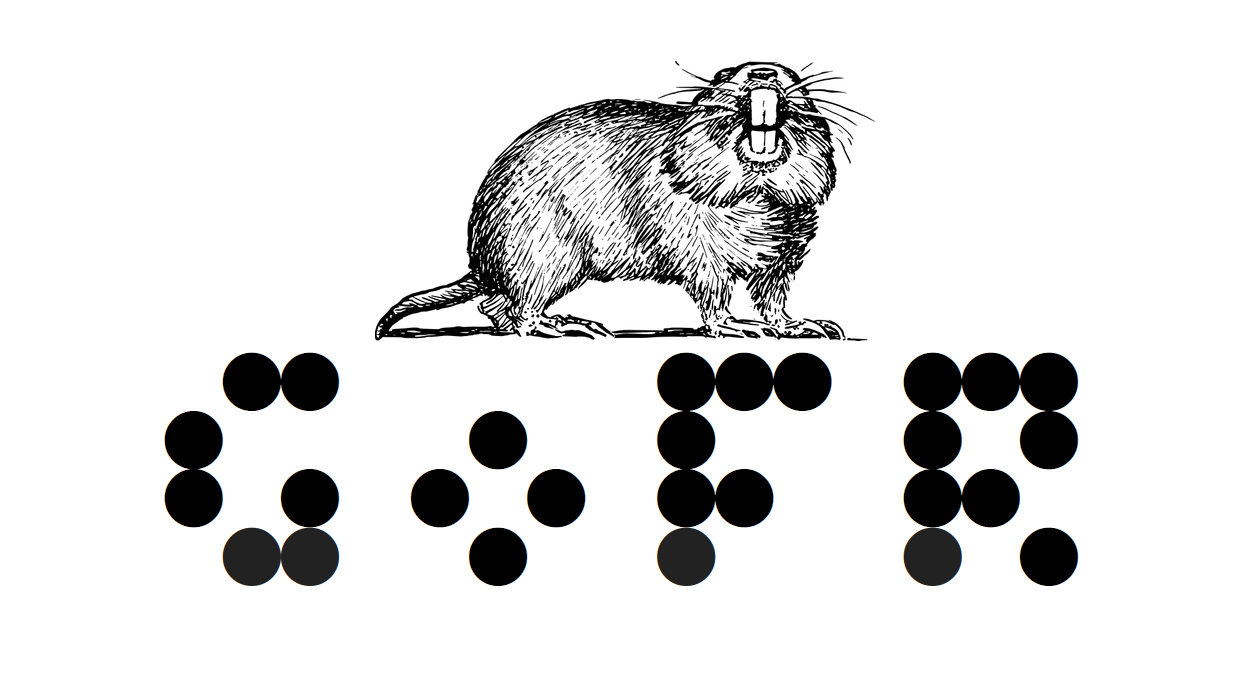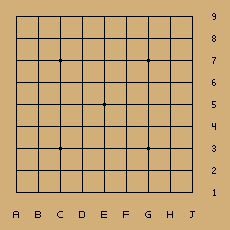GoFR ("Go [language] For Real", pronounced "gopher") is an entropic register-based programming language whose semantics are based on moves made in the board game Go.
GoFR incorporates elements from the traditional East Asian board game Go to define its semantics. Here's an overview of the language's key features:
- A register in GoFR is an object that optionally contains an opcode (function identifier) and a finite number of arguments.
---------------------------------------
| Opcode | N_Args | Arg1 | Arg2 | ... |
---------------------------------------
- The language supports an infinite number of registers, each identified by a unique integer. At any given point during execution, exactly one register is 'targeted' by the register pointer
R, which determines what register will be modified by an action on the Go field.
----------------------
| R0 | Increment | 1 | <- R
----------------------
| R1 | Identity | 3 |
---------------------
- Functions in GoFR are operations that take a finite and well-defined number of arguments. Builtin functions like
Identity,Increment,Multiply, etc. have specific opcodes, and any user-defined functions will have a larger, runtime-specified opcode. - Function arguments are pointers to other registers, except in the case of
Identity, in which the single argument is a literal - When a the final expected argument is loaded into a function's register, if the register is pointed to by
Rit will automatically execute per the documentation below - The language is called entropic because each operation (excluding
Identity) must destroy some amount of information by collapsing to another state, resulting in a less-distinguishable system over time. GoFR's Turing-Completeness relies heavily on the negentropicMoveinstruction (which can create more information than it destroys) and the isentropicLoadinstruction (which can create exactly as much information as it destroys). - User-defined functions must curry their arguments to builtin functions to develop higher-level control
GoFR incorporates rules inspired by the game of Go to govern its execution and manipulation of registers:
- If Black makes a Ko capture (a capture of one board space that could be reversed in one move), the current register pointer (
R) is incremented. - If White makes a Ko capture,
Ris decremented. - If either color passes, the register at position
Ris cleared back to an uninitialized state. - If
Ntiles are captured by either color, and the register at positionRhas no function opcode loaded, then its opcode is set toN. Otherwise, if it does not haveN_Argsfilled (builtins fill this automatically),N_Argsis set toN. Otherwise,Nis loaded as a pointer to register#Ninto the next available argument slot for registerR. - Once the expected number of arguments is loaded into a register, it will execute the function.
These Go-inspired rules add a unique aspect to GoFR's execution and provide a gameplay-like experience to programming.
The above description provides a high-level overview of GoFR's semantics based on the game of Go. More detailed information about the language's syntax, built-in functions, and additional features will be released over time as the language is developed.
Expand Reference Table
| n | Name | N_Args | Description | Collapsed State |
|---|---|---|---|---|
| 1 | Identity |
1 | A special function for many reasons: it does not get executed, and its argument is a constant value rather than a pointer. If a data load is executed in Go while R points to an Identity instruction, it will be overwritten with the new value |
Identity is already in its collapsed state |
| 2 | Jump |
1 | Jumps to the register pointed at by its argument | The Empty register |
| 3 | Move |
3 | Copies the contents of all registers in the range [Arg1:Arg2] to Arg3. E.g. if Move 1 5 6 is executed, registers R1, R2, R3, R4, and R5 will be copied to positions R6, R7, R8, R9, and R10 - maintaining their order |
Identity (Arg2 - Arg1 + 1) |
| 4 | Load |
2 | Loads the data from an Identity pointed at by Arg1 into the next available slot at register Arg2, acting like a Go capture. Load allows for preparing instructions for JumpAndExec as it does not execute fully-loaded functions automatically |
Identity (data @ Arg1) |
| 5 | Increment |
1 | Increments the value pointed at by its argument (will soon be deprecated in favor of Add) | The Empty register |
| 6 | Decrement |
1 | Decrements the value pointed at by its argument (will soon be deprecated in favor of Subtract) | The Empty register |
To maintain Turing-Completeness, JumpAndExec and Break functions are planned. JumpAndExec will jump to register Arg1 and sequentially execute registers until it reaches a Break instruction.
To maintain Turing-Completeness, a JumpNotZero function is planned that will jump to register Arg1 if register Arg2 is an Identity register with a non-zero value.
The following GoFR assembly (the internal translation of Go moves) loads a
constant 1 (via the Identity opcode 1) into R1, loads an Increment operation
(opcode 2) into R2 with an argument of 1. This argument points to R1, indicating
that after execution, R2 should contain a constant value of the increment of 1,
which is 2. This code example is also represented by both of these games of Go:
Game Animations
| Step in ASM | Move in Game |
|---|---|
| 1 | 7 |
| 2 | 17 |
| 3 | 19 |
| 4 | 24 |
| 5 | 25 |
| Step in ASM | Move in Game |
|---|---|
| 1 | 3 |
| 2 | 12 |
| 3 | 13 |
| 4 | 17 |
| 5 | 19 |
- Initial Bank
--------- | Empty | <- R --------- - Load 'Identity' opcode (N_Args is filled automatically for builtins)
----------------------- | R1 | Identity | N=1 | <- R ----------------------- - Load the constant '1' into the first argument of R1
--------------------------- | R1 | Identity | N=1 | 1 | <- R --------------------------- - Increment R
--------------------------- | R1 | Identity | N=1 | 1 | --------- | Empty | <- R --------- - Load 'Increment' opcode
--------------------------- | R1 | Identity | N=1 | 0 | ------------------------ | R2 | Increment | N=1 | <- R ------------------------ - Load the register pointer '1' into the first argument of R2
--------------------------- | R1 | Identity | N=1 | 1 | ---------------------------- | R2 | Increment | N=1 | 1 | <- R ---------------------------- - When a function is supplied with the correct number of arguments, it is executed automatically. Here, R1 has been set to a constant value of 1 + 1 = 2
--------------------------- | R1 | Identity | N=1 | 1 | --------------------------- | R2 | Identity | N=1 | 2 | <- R ---------------------------
This example computes 5 + 3 recursively, storing the result in R1. The IR can be found in main.ml:_self_replicating_test



